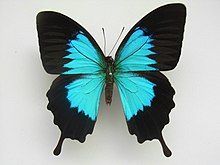Papilio ulysses
| Ulysses butterfly | |
|---|---|

| |
| Scientific classification | |
| Kingdom: | Animalia |
| Phylum: | Arthropoda |
| Class: | Insecta |
| Order: | Lepidoptera |
| Family: | Papilionidae |
| Genus: | Papilio |
| Species: | P. ulysses
|
| Binomial name | |
| Papilio ulysses | |
| Subspecies | |
| |
Papilio ulysses, the Ulysses butterfly (also commonly known as the Blue emperor), is a large swallowtail butterfly of Australia, Indonesia, Papua New Guinea and the Solomon Islands. Its size varies depending on subspecies, but the wingspan is about 10.5 cm (4.1 in) in Queensland.[1]
This butterfly is used as an emblem for tourism in Queensland, Australia.
Description[]

The Ulysses butterfly typically has a wingspan of about 14 cm (5.5 in), but depending on subspecies has some variations in size (western subspecies largest). The upperside of the wings are an iridescent electric blue; the underside is a more subdued black and brown. The colours are produced by the microscopic structure of the scales, a phenomenon called structural colouration.[2]
The female of the species is different from the male in that she has little crescents of blue in the back, upside sections of her hindwings, where there is only black for males. When the butterfly is perched the intense blue of its wings is hidden by the plainer brown under side of its wings, helping it to blend in with its surroundings. When in flight, the butterfly can be seen hundreds of metres away as sudden bright blue flashes. Males are strongly attracted to the colour blue, including blue objects which are sometimes mistaken for females.
Diet and conservation[]

Conservation[]
The Ulysses butterfly inhabits tropical rainforest areas and suburban gardens. The Australian government requires breeders to obtain permits, although the species is not endangered. In the past, this butterfly had been threatened but planting pink flowered doughwood has increased its numbers. Reduction in the number of the Euodia trees, a tree heavily used for laying eggs and for leaves eaten by caterpillars, may threaten the survival of this butterfly. Females favour small trees up to 2 metres tall to lay their eggs.
Diet[]
The larval food plants of this butterfly include kerosene wood, a variety of Citrus, and Euodia. In Australia, the Ulysses butterfly imago is known to feed from the blossoms of the pink flowered doughwood, a tree with clusters of small pink flowers that extrude from its branches.[3]
References[]
- ^ Wildlife of Tropical North Queensland: Cooktown to MacKay. Queensland Museum. (2000), p. 114.
- ^ P. Vukusic, J. R. Sambles, C. R. Lawrence, R. J. Wootton (2001) Sculpted-multilayer optical effects in two species of Papilio butterfly. Applied Optics 40:1116-1125 "Archived copy" (PDF). Archived from the original (PDF) on 2007-02-22. Retrieved 2007-11-01.CS1 maint: archived copy as title (link)
- ^ "Facts About the Migration of the Ulysses Butterfly". PawNation. Archived from the original on 15 August 2013. Retrieved 1 November 2014.
Further reading[]
- Erich Bauer and Thomas Frankenbach, 1998 Schmetterlinge der Erde, Butterflies of the World Part I (1), Papilionidae Papilionidae I: Papilio, Subgenus Achillides, Bhutanitis, Pooples. Edited by Erich Bauer and Thomas Frankenbach. Keltern: Goecke & Evers; Canterbury: Hillside Books, ISBN 9783931374624
External links[]
![]() Media related to Papilio ulysses at Wikimedia Commons
Media related to Papilio ulysses at Wikimedia Commons
- Papilio
- Butterflies described in 1758
- Butterflies of Asia
- Butterflies of Australia
- Taxa named by Carl Linnaeus